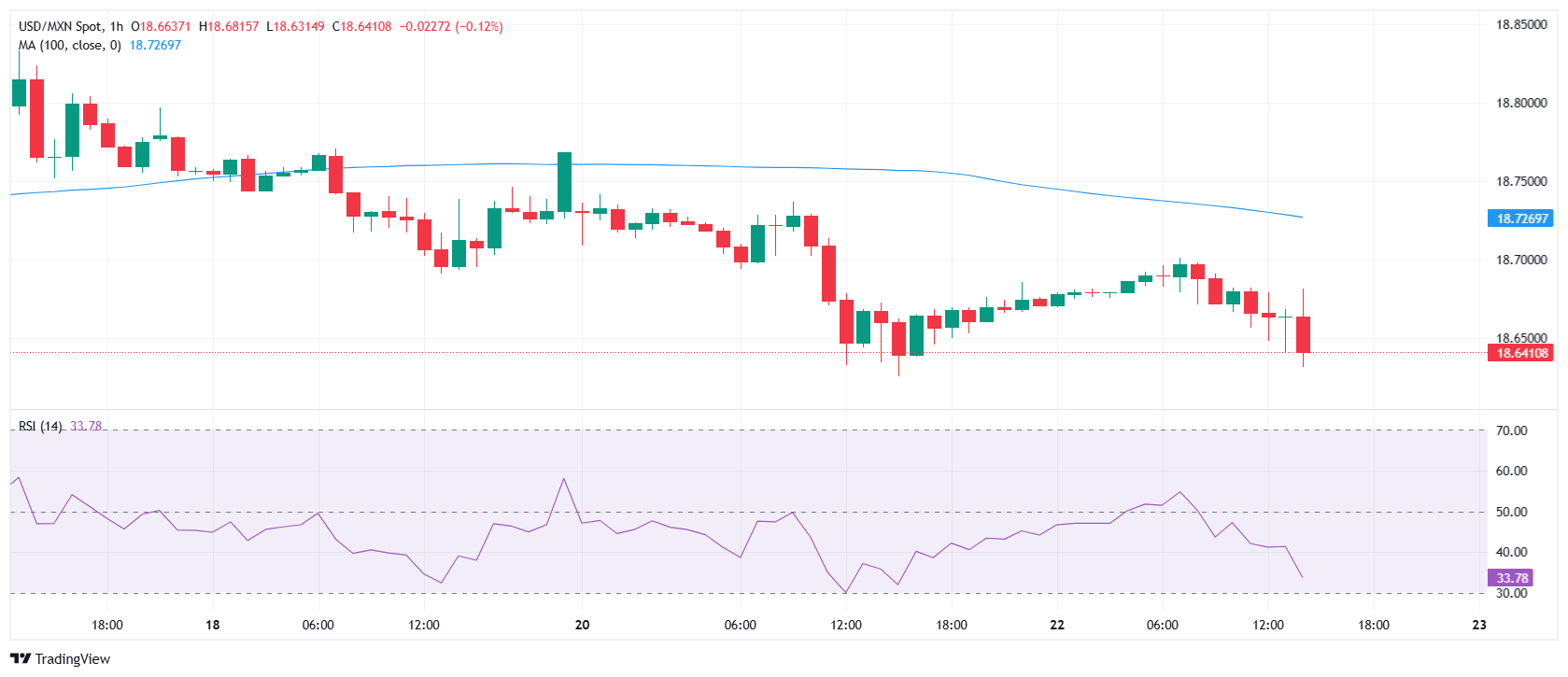- The USD/MXN records losses for the third consecutive day.
- The US dollar remains weakened by concerns regarding tariffs and independence of the Fed.
- The retail sales of Mexico register their greatest intermensual increase in two years.
The USD/MXN records losses for the third consecutive day on Tuesday, moving in the vicinity of the minimum eleven days reached yesterday in 18.62. The pair has opened the day testing a daily maximum in 18.70, but in the last two hours it has fallen to a floor of 18.64, and now quotes over 18.63, losing 0.18% in the day.
Mexico’s retail sales drive Mexican peso while threats on the independence of Fed weigh on the dollar
The National Institute of Statistics and Geography (INEGI) has published today the data of retail sales from Mexico, revealing a monthly increase of 1.8% in May Faced with the 1% decrease in April, its greatest increase in almost two years. At the year -on -year level, the indicator has grown 2.7% after falling 2% the previous month. The data has given impulse to the Mexican peso, also taking advantage of the widespread weakness of the dollar on the Forex board.
The US dollar index (DXY) continues to be pressed down below the 98.00 zone on Tuesday, affected by several factors.
First of all, The fears of the independence of the Fedran to the green ticket. In recent days, the Republican party is besieging the president of the Federal Reserve, Jerome Powell. Anna Paulina Luna, federal damnant for Florida of the Republican Party, accused Poweell of Perjurio before the US congress yesterday Monday, while the secretary of the Treasury, Scott Besent, pressed the Fed ensuring that a reduction of interest rates would unlock the mortgage market. In the last hours, however, Besent has made statements in Fox Business Network in which he assured that the mandate of the president of the Fed ends in May and there is nothing to indicate that he must resign at this time.
On the other hand, uncertainty about tariffs grows due to the proximity of August 1, affecting the dollar more at the moment than its counterparts. The US has not yet reached an agreement with Mexico, which a priori should face 30% taxes if a pact is not achieved.
Waiting for news in the Tariff Front, the focus will turn to the next economic data of the US and Mexico, since they could generate movements in the USD/MXN. He Thursday will be the key day, since Mexican inflation of the first half of July will be knownwaiting for a rebound at 0.27% in the general CPI compared to the previous 0.1%. For its part, andSadados Unidos will publish that weekly subsidy request figures and manufacturing PMIs that same day Julio Preliminaries.
USD/MXN Price levels
The USD/MXN is in a firmly bassist tendency in short, medium and long term graphics, with the 14 -day relative force index (RSI) below 40 in one -hour temporalities, four hours and one day, which also indicate new declines in the next few hours.
The first important support appears in 18.55, minimum of 2025 and the last year reached on July 9. Below, the pair can descend around 17.60, July 2024.
Upwards, the USD/MXN will have to clearly overcome the resistance zone marked by the 100 -hour mobile average in four hours in 18.72/18.69, respectively. Above, the objective will be in 18.88, this month registered on day 15.
USD/MXN 1 hour graphic

Mexican peso – frequent questions
The Mexican weight (MXN) is the most commercialized currency among its Latin American peers. Its value is widely determined by the performance of the Mexican economy, the country’s central bank policy, the amount of foreign investment in the country and even remittance levels sent by Mexicans living abroad, particularly in the United States. Geopolitical trends can also affect MXN: for example, the Nearshoring process (or the decision of some companies to relocate the manufacturing capacity and supply chains closer to their countries of origin) is also considered a catalyst for the Mexican currency, since the country is considered a key manufacturing center in the American continent. Another catalyst for MXN is oil prices, since Mexico is a key exporter of the raw material.
The main objective of the Central Bank of Mexico, also known as Banxico, is to maintain inflation at low and stable levels (in or close to its 3%target, the midpoint of a tolerance band between 2%and 4%). To do this, the bank establishes an adequate level of interest rates. When inflation is too high, Banxico will try to control it by raising interest rates, which makes the indebtedness of homes and companies more cooling, thus cooling the demand and the economy in general. The highest interest rates are generally positive for Mexican weight (MXN), since they lead to higher yields, which makes the country a more attractive place for investors. On the contrary, lower interest rates tend to weaken the MXN.
The publication of macroeconomic data is key to evaluating the state of the economy and can have an impact on the valuation of the Mexican weight (MXN). A strong Mexican economy, based on high economic growth, low unemployment and high confidence is good for MXN. Not only attracts more foreign investment, but it can encourage the Bank of Mexico (Banxico) to increase interest rates, particularly if this fortress is accompanied by high inflation. However, if the economic data is weak, the MXN is likely to depreciate.
As an emerging market currency, the Mexican weight (MXN) tends to rise for periods of risk, or when investors perceive that the general market risks are low and, therefore, are eager to participate in investments that carry a higher risk. On the contrary, the MXN tends to weaken at times of market turbulence or economic uncertainty, since investors tend to sell higher risk assets and flee to the most stable safe shelters.
Source: Fx Street
I am Joshua Winder, a senior-level journalist and editor at World Stock Market. I specialize in covering news related to the stock market and economic trends. With more than 8 years of experience in this field, I have become an expert in financial reporting.







